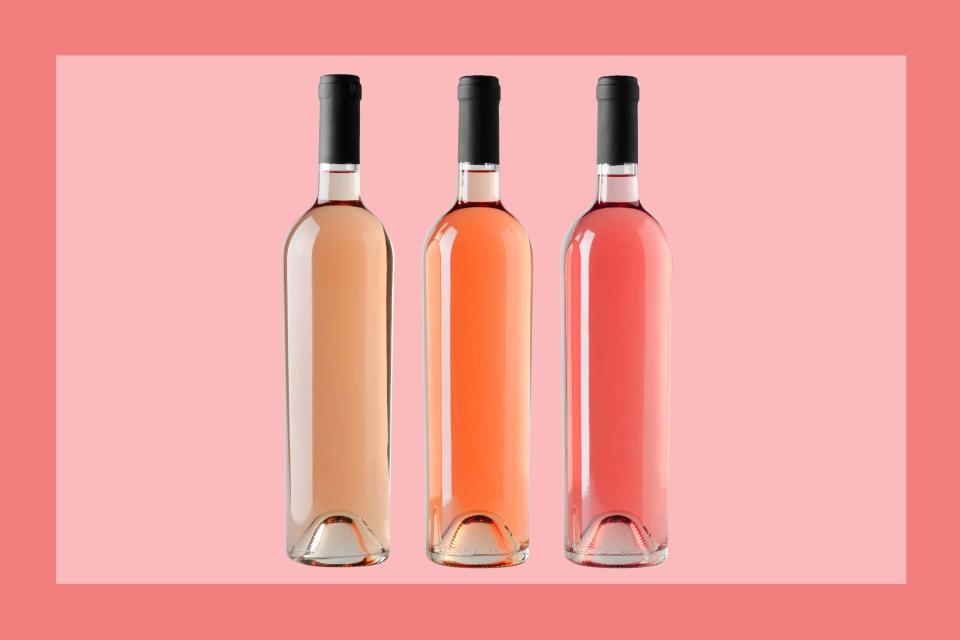We Can't Stop Recommending These Three Rosés for Red Wine Drinkers
These crowd-pleasing wines bridge the gap between red wine and rosé drinkers with ease.

Getty
The characteristics that make chilled red wines so popular, like higher acidity, low levels of tannins, and fruit-forwardness are equally present in deeper pigmented rosés. Unfortunately, negative stereotypes about quality and sweetness continue to plague rosés that present darker in color than the consumer-friendly salmon pink.
The truth is, if you frequently reach for chillable reds, you’ll likely fall in love with darker-hued rosés, too — and the pros agree.
Does the color of a rosé wine impact its quality?
Kirsten Bhattacharya, manager and sommelier at Charleston-based Graft, emphasizes that color in wine doesn’t directly translate to quality level, but can rather indicate the structure and body of the wine. “Stylistically, rosés with a deeper color seem to have a little more texture,” she says.
Michaela Johnson, a sommelier at New York City’s Le Jardinier, further explains that darker hues in rosé often speaks more to the vinification choices made by the winemaker, not the quality in the bottle.
Another stereotype surrounding darker-hued rosés is that they’re sweeter than their pinker counterparts. Liz Rogero, general manager and beverage director at Fausto, an Italian restaurant in Brooklyn, notes that dozens of wine regions have historically leaned into darker rosés as the preferred style, and that deeper color simply often means the grapes spend a longer time in contact with their skins during fermentation.
“These wines can still feel bright and lifted due to climate, soil, and deft winemaking, but with a fuller body, [are] able to stand up to heavier, richer dishes that might typically pair with a red wine,” she says.
Bhattacharya agrees. “I would love to see the myth that darker rosés have residual sugar disappear!” she says. Producers in regions like Abruzzo and Tavel traditionally vinify their rosés to have darker hues. Although these wines still retain ample freshness, Bhattacharya says guests frequently write them off because of their color.
Adam Greer, sommelier at Blu on Hudson in Weehawken, New Jersey, adds that many Americans likely associate darker-hued rosés with sweetness due to mass-produced domestic examples of the past, though today, this is simply a misconception.
Related: The 33 Best Rosés to Drink Right Now
Why darker rosés pair well with food
Rogero loves darker-hued rosés for their versatility, especially because these wines can easily bridge the gap from lighter, fresher antipasti to richer, more savory main dishes.
Greer says that approximately 50% of the rosés on his list are more robust in style, as he finds that these wines pair better with food thanks to their unique combination of freshness and complexity.
“Quite simply, these wines are to be enjoyed with a meal,” he says. Greer adds that dark-hued rosés can also be enjoyed both during colder months — that is, at a time when most consumers wouldn’t consider ordering rosé — yet are also great alternatives for red wine lovers who seek a refreshing wine that “mimics a bold red in structure.”
Three rosé-producing regions to try if you love red wine
Tavel
Situated in France’s southern Rhône region, Tavel is a rosé-exclusive appellation synonymous with producing darker-hued expressions of the style.
“Tavel is my favorite style of darker rosé because it's a wine that can even age and be full of surprises,” says Jean-Benoit Issele, chef sommelier at Apéritif, a fine dining restaurant in Ubud, Bali. Issele notes that nine different grape varieties including Grenache, Cinsault, and Syrah are permitted in Tavel rosés (which are mostly blends), and each can contribute to the complexity and luminosity that is so characteristic of Tavel wines. Greer agrees, stating that the wines teeter right on the brink of rosé and red wine. Color-wise, these wines, aren’t too far off from the beloved chillable red wines of Beaujolais.
Cerasuolo d’Abruzzo
Crafted in the coastal Abruzzo region of Italy, Cerasuolo, which loosely translates to cherry, is a style of rosé produced from the local Montepulciano grape variety. “The wines] are made from 100% Montepulciano grapes, whose thicker skin can add robust color and tannins quickly,” says Greer, who describes the wines as bright and robust, with balanced acidity and a structure reminiscent of red wine.
Related: These 10 Rosés Are the Best You Can Buy for Less Than $20
Spanish Rosado
While not all rosés wines from Spain are darker hued, many of the country’s signature rosados fall on the more concentrated side of the spectrum.“With deeper rosés, you might get that same vibe [as chillable reds], but a lot of them have more aromatic complexity or are even texturally more interesting than a lot of lighter reds that read ‘juice box,’” says Bhattacharya, giving a special shout out to José Luis Ripa Rosado made from a blend of Garnacha and Tempranillo.
For more Food & Wine news, make sure to sign up for our newsletter!
Read the original article on Food & Wine.

